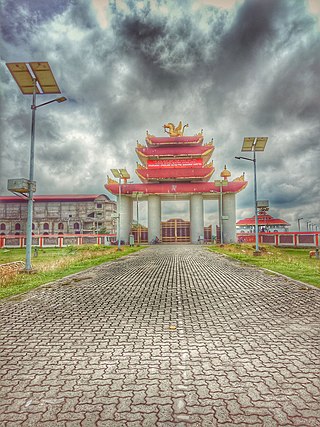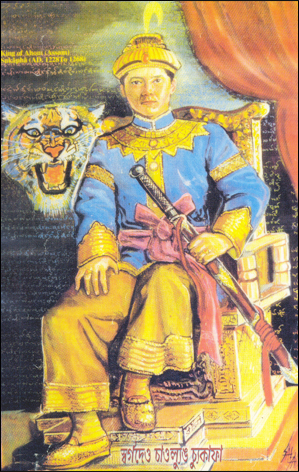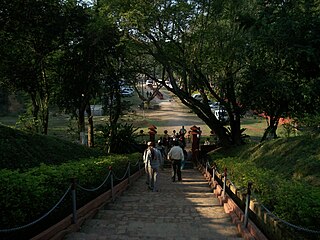
Ahomisation was an assimilation process in the former Ahom kingdom of Assam by which the people from different ethnic groups in the region became a part of what is now considered as the Ahom population. [1]

Ahomisation was an assimilation process in the former Ahom kingdom of Assam by which the people from different ethnic groups in the region became a part of what is now considered as the Ahom population. [1]
Sukaphaa (reign 1228–1268 CE), was a Tai prince originally from Mong Mao, who along with about nine thousand soldier-agriculturalists arrived in what is now Assam in 1228. [2] After moving between different places, he finally settled in 1253 at Charaideo in eastern Assam and started forming a state. Upon settling in Assam, Sukaphaa established peaceful relations with the local ethnic groups, especially from the Borahi and the Moran. He later married the daughters of both Badaucha, the Moran Chief, and Thakumatha, the Borahi chief and established cordial relations with them. As he began establishing his domain, he avoided regions that were heavily populated. [3] He also encouraged all his Tai soldiers as well as the members of the Tai elites to marry with the locals, which led to the beginning of the process called Ahomisation, he and his mostly male followers creating the admixed population known as the Ahoms. [4] The Shan-Tai settlers displayed great assimilative capacity. While the Shan invaders called themselves Tai, they came to be referred to as Āsām, Āsam and Acam by the indigenous peoples of the region. [5] The modern Assamese word Āhom by which the Tai people were known was derived from Āsām or Āsam. Socially, they fully identified with the multi-ethnic groups of their occupied territory, and the new name Ahom legitimised and recognised their political supremacy and leadership. The conquest of the Moran and Borahi ethnic groups at the initial stage produced the conquest society. The Tai settlers did not exterminate the vanquished population, but instead took them as partners in peace and development. [6]
The Tai settlers brought with them the superior technique of wet-rice cultivation, and believed that they were divinely ordained to bring the fallow land under the plow. They adopted many stateless shifting cultivators of the region into their fold, [7] though they were also conscious of their numerical inferiority. [8] As a result, the Tai-Ahom polity initially absorbed people from various ethnic groups of the region such as Borahi, Moran and Naga. Later, after subjugating the Chutiya kingdom and Dimasa Kingdom, much of the Chutia and the Dimasa-Kachari populace too were absorbed into the Ahom population. [9] Many indigenous people from various ethnic groups were ceremonially adopted into Ahom clans, as recorded in the chronicles known as "Buranji". Thus the illustrious Ahom family of Miri Sandikai was founded by one Miri (Mising), the adopted son of a Burhagohain. King Gadadhar Singha (1681–1696) accepted two Naga princesses as his consorts. The new converts, if capable, were even elevated to important administrative posts. Thus the second Borphukan became the governor of Lower Assam, who was the son of a Naga of Banferra clan. Queen Phuleswari, who took the regalia to her hand during the reign of king Siva Singha (1714–1744), appointed a Bhutanese youth as her page. Kancheng, the first Barpatra Gohain was born and brought up in a Naga family. [8] Miri-Sandikoi and Moran-Patar were Sandikoi and Patar from the Mising and Moran communities, [10] This was true even for the priestly clans: Naga-Bailung, Miri-bailung and Nara-Bailung [11] Ahom Chutias formed the major sub-division. They were termed as such as they intermarried with the already mixed Ahoms. Most of them have been absorbed into the Ahom fold over time. [12] They held various position in the Ahom kingdom's administration as seen with Momai Tamuli Borbarua, Langi Panisiya Borphukan, [13] Rupchandra Borbarua, [14] Kirtichandra Borbarua, Lachit Borphukan, Piyoli Borphukan, Badanchandra Borphukan, Thumlung Borgohain, [15] Banrukia Gohain(during Susenpha's reign). Even during Sukapha's reign, many Chutia or Moran families like Som-chiring and Changsai were absorbed into the Ahom fold. Majority of Ahoms of the Chetia clan as well as the Lahon clan originated from the Chutia community. [16] In this manner, numerous ethnic groups hailing from both the plains and the hills across the region were assimilated into the 'Ahom' population.
The Tai-Ahoms married liberally outside their own exogamous clans and their own traditional religion resembled the religious practices of the indigenous peoples. [17] [18] The Borahis, were completely subsumed into the Ahom fold, though the Morans even today maintain their independent ethnicity, thus terms like 'Sutiya-Ahom', 'Kachari-Ahom', 'Moran-Ahom' have been used in the Buranjis (chronicles). During the pre-colonial period of Assam, the Ahoms were not an ethnic community like it is considered as now, but rather Ahoms were a relatively open status group. Any community coming into the socio-economic fold of the Ahom state could claim the Ahom status with active consent of the king. [19] The modern Ahom people and their culture are a syncretism of the original Tai and their culture [20] and local Tibeto-Burman peoples and their cultures they absorbed in Assam. After the initial contact of the Tai-Ahoms with the local people of the region, the Tai speakers learnt the local language and culture. With better communication and proper running of the Ahom administration, they learnt the local Assamese language. The adoption of Assamese language also changed the language of Chronicle writings, the Buranji(s), where they write their all events. Even though the already mixed group known as 'Ahom' made up a relatively very small portion of the kingdom's population, [9] they still maintained their original Tai-Ahom language alongside Assamese and practised their traditional religion until the 16th century, when the Ahom court, completely adopted the local language of the region, the Assamese language. [21]
This process of Ahomisation went on for till the mid-16th century when the mixed Ahom society itself came under the direct Hindu influence. [17] In the contexts of conquest, the general process is the fact that the subjugated groups normally adopt the language and customs of the conquerors, this was the root of the Ahomisation process. But in Assam even after the process of Ahomisation started in the region, the Ahom kings observed that complete political influence in the country was not possible. And with the expansion of territory of the Ahom kingdom and with the further inclusion of a diverse population a reverse process took place. The conquerors had no other alternative but to sanction the use of the language and culture of the conquered people in the common level of the totality. [6] So after the subjugation of Chutia territories as in Chutia Kingdom, the process of Ahomisation gave way to the process of Sanskritisation (Hinduisation). The process of Sankritisation increased significantly in the 16th and 17th centuries after the expansion of Ahom kingdom westward which led to absorption of many Hindu subjects. [22]
The first Hindu cultural elements came into Ahom royal palace during reign of Sukhaangphaa (1293–1332) when the Koch king of Kamata Kingdom that ruled what is now Western Assam, North Bengal and Northern Bangladesh, offered his daughter to the Ahom king to conclude the battle between Koch and Ahom kingdom. [23] This was the first recorded marriage of an Ahom king with a Hindu princess outside of the kingdom and this event of marriage brought in some Hindu elements to the Ahom royal palace. After the annexation of Chutiya kingdom, Kachari Kingdom and Baro-Bhuyans kingdom, the Ahoms assimilated their own culture with them. The Ahom royal also later appointed the some Chutiyas and Bhuyans in their office, inter-married and had relations with them. Thus, the cultural assimilation took place which majorly impacted the social structure, belief and practices in the Ahom society.
Gradually, the Ahom royal accepted the influence of Hinduisation, which led to Hindu religion's entry into the Ahom royal palace during the reign of Sudangphaa also known as Bamuni Kowar (reign: 1397–1407). Sudangphaa also appointed a Brahmana as an advisor in the Ahom Royal court and he was the first Ahom king to adopt the coronation of Singarigharutha. Singarigharutha was the traditional coronation ceremony of an Ahom king. It was believed that even though an Ahom prince became a king, he could not attain the status of a full-fledged monarch until his Singarigharutha ceremony was completely performed. Therefore, each Ahom ruler after their accession to the throne tried to organize the ceremony as soon as possible.
Suhungmung (reign: 1497–1539) was the first Ahom king to adopt the Hindu title Swarga-Narayan, a Sanskrit equivalent of Tai-Ahom's Chao-Pha. After the reign of Suhungmung the Ahom king prefer to use their Hindu names in the official records. [24] The kings who were traditionally known with the title of Chao-Pha were replaced by the title of Swargadeo and since then Ahom kings came to be known as the 'Swargadeo'.
The priestly classes of the Ahom like the Mohan, Deodhai and Bailung, mostly remained outside the purview of mainstream Hinduism and continued to express their unwillingness to come into the fold of the Brahmin Hindus.[ citation needed ] However the traditions of Tai culture and religion can be found to be preserved by some priestly classes in rituals, marriages and festivals which today reflect the Ahom style of living.

The Ahom or Tai-Ahom is an ethnic group from the Indian states of Assam and Arunachal Pradesh. The members of this group are admixed descendants of the Tai people who reached the Brahmaputra valley of Assam in 1228 and the local indigenous people who joined them over the course of history. Sukaphaa, the leader of the Tai group and his 9,000 followers established the Ahom kingdom, which controlled much of the Brahmaputra Valley in modern Assam until 1826.

The Ahom dynasty (1228–1826) ruled the Ahom Kingdom in present-day Assam, India for nearly 598 years. The dynasty was established by Sukaphaa, a Shan prince of Mong Mao who came to Assam after crossing the Patkai mountains. The rule of this dynasty ended with the Burmese invasion of Assam and the subsequent annexation by the British East India Company following the Treaty of Yandabo in 1826.

The Dimasa Kingdom was a late medieval/early modern kingdom in Assam, Northeast India ruled by Dimasa kings. The Dimasa kingdom and others that developed in the wake of the Kamarupa kingdom were examples of new states that emerged from indigenous communities in medieval Assam as a result of socio-political transformations in these communities. The British finally annexed the kingdom: the plains in 1832 and the hills in 1834. This kingdom gave its name to undivided Cachar district of colonial Assam. And after independence the undivided Cachar district was split into three districts in Assam: Dima Hasao district, Cachar district, Hailakandi district. The Ahom Buranjis called this kingdom Timisa.

Sukaphaa, also Siu-Ka-Pha, the first Ahom king in medieval Assam, was the founder of the Ahom kingdom and the architect of Assam. A prince of the Su/Tsu (Tiger) clan of the Mao-Shan sub-tribe originally from present-day Mong Mao, Yunnan Province, China, the kingdom he established in 1228 existed for nearly six hundred years and in the process unified the various ethnic groups of the region that left a deep impact on the region. In reverence to his position in Assam's history the honorific Chaolung is generally associated with his name.

Suhungmung, or Dihingia Roja I was one of the most prominent Ahom Kings who ruled at the cusp of Assam's medieval history. His reign broke from the early Ahom rule and established a multi-ethnic polity in his kingdom. Under him the Ahom Kingdom expanded greatly for the first time since Sukaphaa, at the cost of the Chutia and the Dimasa kingdoms. He also successfully defended his kingdom against Muslim invasions, first by a general called Bar Ujjir and another by Turbak Khan. During his time, the Khen dynasty collapsed and the Koch dynasty ascended in the Kamata kingdom. His general, Ton-kham, pursued the Muslims up to the Karatoya river, the western boundary of the erstwhile Kamarupa Kingdom, the farthest west an Ahom military force had ventured in its entire six hundred years of rule.

The Ahom kingdom was a late medieval kingdom in the Brahmaputra Valley that retained its independence for nearly 600 years despite encountering Mughal expansion in Northeast India. Established by Sukaphaa, a Tai prince from Mong Mao, it began as a mong in the upper reaches of the Brahmaputra based on wet rice agriculture. It expanded suddenly under Suhungmung in the 16th century and became multi-ethnic in character, casting a profound effect on the political and social life of the entire Brahmaputra valley. The kingdom became weaker with the rise of the Moamoria rebellion, and subsequently fell to repeated Burmese invasions of Assam. With the defeat of the Burmese after the First Anglo-Burmese War and the Treaty of Yandabo in 1826, control of the kingdom passed into East India Company hands.

Bodo–Kacharis is a name used by anthropologist and linguists to define a collection of ethnic groups living predominantly in the Northeast Indian states of Assam, Tripura, and Meghalaya. These peoples are speakers of either Bodo–Garo languages or Assamese. Some Tibeto-Burman speakers who live closely in and around the Brahmaputra valley, such as the Mising people and Karbi people, are not considered Bodo–Kachari. Many of these peoples have formed early states in the late Medieval era of Indian history and came under varying degrees of Sanskritisation.

Barua is a common Assamese surname. This term is different and not to be confused with the surname used by Buddhists from Bangladesh, Myanmar and Tripura, who also use Barua as surname.

Charaideo or Che-Rai-Doi is a historic town situated in Charaideo district, Assam, India. Charaideo was established by the first Ahom king Chao Lung Siu-Ka-Pha in the year 1253 CE as the first capital of the Ahom kingdom. Even though the capital was shifted to different cities over the course of 600 years of Ahom rule, Charaideo remained the symbolic centre of Ahom power in Assam. It is now famous for its vast collection of maidams (tumuli) which are the burial mounds of the ruling Ahom kings and members of the Ahom royalty.

Sukhrungphaa or Swargadeo Rudra Singha was the 30th Ahom king, reigning from 1696 to 1714 A.D. His father Gadadhar Singha freed Assam from the Mughal disturbances and internal conspiracies, thereby Rudra Singha inherited a stable state and government and had the advantage of the solid foundations laid by his father. He devoted his time to transform Assam into a first-rate power in India. He stopped the persecution of the Neo-Vaisnava sect and built temples, several public works, and patronized art, literature, and culture. Rudra Singha is also famed for being the real father of Ahom architecture. He giving up the isolationist policy of his predecessors forged diplomatic ties with various states of that time and established extensive trade with Bengal.
Borpatragohain was the third of the three great Gohains (counsellors) in the Ahom kingdom. This position was created by Suhungmung Dihingia Raja in the year 1527 when Konsheng was made the first Borpatrogohain. The designation was borrowed from Vrihat-patra, the Habung dependent of the Chutiya king.

Suremphaa, or Rajeswar Singha, the fourth son of Rudra Singha, became the king of the Ahom kingdom after the death of his brother King Pramatta Singha. Rudra Singha's third son, Mohanmala Gohain, was considered ineligible for kingship as his face was pitted with smallpox marks. According to the norm established after Sulikphaa Lora Roja, an Ahom prince had to be free from any physical disability, defects or deformities to become a king.

The People of Assam inhabit a multi-ethnic, multi-linguistic and multi-religious society. They speak languages that belong to four main language groups: Tibeto-Burman, Indo-Aryan, Tai-Kadai, and Austroasiatic. The large number of ethnic and linguistic groups, the population composition, and the peopling process in the state has led to it being called an "India in miniature".

The Assamese people are a socio-ethnic linguistic identity that has been described at various times as nationalistic or micro-nationalistic. This group is often associated with the Assamese language, the easternmost Indo-Aryan language, and Assamese people mostly live in the Brahmaputra Valley region of Assam, where they are native and constitute around 56% of the Valley's population. The use of the term precedes the name of the language or the people. It has also been used retrospectively to the people of Assam before the term "Assamese" came into use. They are an ethnically diverse group formed after centuries of assimilation of Austroasiatic, Tibeto-Burman, Indo-Aryan and Tai populations, and constitute a tribal-caste continuum—though not all Assamese people are Hindus and ethnic Assamese Muslims numbering around 42 lakh constitute a significant part of this identity The total population of Assamese speakers in Assam is nearly 15.09 million which makes up 48.38% of the population of state according to the Language census of 2011.

Suklingphaa, or Kamaleswar Singha, was a king of the Ahom kingdom. He came to power when he was a toddler, and died in his teens during a small pox epidemic. The de facto ruler during his reign was Purnanada Burhagohain, who was able to consolidate power after installing him on the throne; and his parents Kadamdighala and Numali also were very powerful. Kamaleswar Singha's reign witnessed the suppression of Moamoria rebellion and restoration of Ahom rule over Upper Assam. The Dundiya Revolution in Kamrup was also suppressed during his reign. In Nagaon, the Ahom army also managed to defeat a coalition of Moamoria rebels and the Kacharis of Kachari Kingdom. Much of this was the handiwork of Purnananda Burhagohain and not Kamaleshwar Singha.

The Chutia Kingdom was a late medieval state that developed around Sadiya in present Assam and adjoining areas in Arunachal Pradesh. It extended over almost the entire region of present districts of Lakhimpur, Dhemaji, Tinsukia, and some parts of Dibrugarh in Assam, as well as the plains and foothills of Arunachal Pradesh. The kingdom fell around the year 1524 to the Ahom Kingdom after a series of conflicts and the capital area ruled by the Chutia rulers became the administrative domain of the office of Sadia Khowa Gohain of the Ahom kingdom.

The Tiwa people, are a Tibeto-Burmese ethnic group primarily inhabiting the Northeast Indian states of Assam, Meghalaya, Arunachal Pradesh, Manipur and Nagaland, and some parts of neighbouring Bangladesh and Myanmar.

Suhenphaa was the king of Ahom kingdom from 1488 CE to 1493 CE. His reign was characterized by the expansion of Ahom kingdom which resulted in conflicts with the Nagas and with the Kachari kingdom. He was successful in the military actions against the Nagas, while in case of Kacharis, he suffered defeat and had to sue for peace with the Kacharis. He was assassinated by one Ahom of Tairungban clan.

The Chutia people are an ethnic group that are native to Assam and historically associated with the Chutia kingdom. However, after the kingdom was absorbed into the Ahom kingdom in 1523–24, the Chutia population was widely displaced and dispersed in other parts of Upper Assam as well as Central Assam. They constitute one of the core groups that form the Assamese people.

The Moamoria were the adherents of the egalitarian, proselytizing Mayamara Satra of 18th-century Assam, who initiated the Moamoria rebellion against the Ahom kingdom in the 18th century. The rebellion weakened the Ahom kingdom to such an extent that the kingdom became vulnerable to repeated Burmese invasions of Assam and the subsequent colonization by the British. The Moamorias were also called Mataks. Over time, the main groups that had supported the Ahom kingdom came to owe allegiance to the Moamara sattra: Morans, the Sonowal Kacharis (gold-washers), Chutias, professional castes such as Hiras (potters), Tantis (weavers), Kaibartas, and Ahom nobles and officers. The largest group among the Mataks were the Morans, followed by the Chutias.
{{citation}}: CS1 maint: location missing publisher (link)